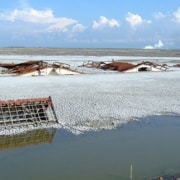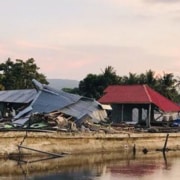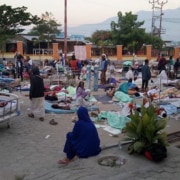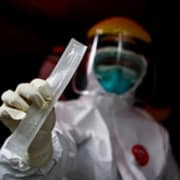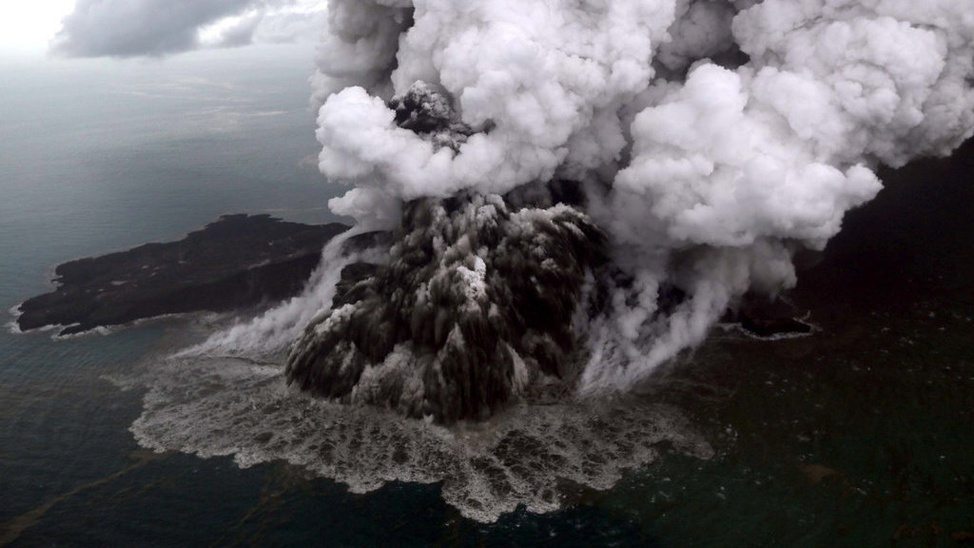
The eruption and partial collapse of the Anak Krakatau volcano in the Sunda Strait in December caused a tsunami that was the last in a string of natural disasters across Indonesia in 2018. Photo by Nurul Hidayat for Antara.
A series of major disasters throughout Indonesia in 2018 made sure the year left a mark in the nation’s collective memory.
Not long after an earthquake shook North Lombok in West Nusa Tenggara in August, another quake in September hit Palu, Sigi and Donggala in Central Sulawesi, accompanied by a tsunami and soil liquefaction, which turned solid ground to waves. Then when the year was almost up, the eruption and partial collapse of a volcano in the Sunda Strait in December caused a tsunami that washed away parts of the coastline in Banten and Lampung.
When disasters strike Indonesia, the nation is swift to respond. But to maintain a functioning health system in the face of a crisis, disaster response alone is not enough. Fortunately, the paradigm is slowly changing from a focus only on response towards better preparedness and disaster risk reduction but there is still a long way to go.
The health sector views disasters as determinants of public health, as well as potential causes of health crises in a society. The main principle of disaster management in the health sector is therefore that when a disaster strikes, a well-functioning system that can support the usual health targets and objectives (as per the World Health Organization framework for six building blocks of a health system), should be maintained. This requires good preparation, or what is termed “disaster health preparedness”.
After the 2004 tsunami in Aceh and 2009 earthquake in Padang, Indonesia’s disaster management efforts became better organised under the National Disaster Management Agency (BNPB) and its regional counterparts (BPBD), bodies that coordinate efforts across sectors, including the health sector.
Yet despite these improvements and the country’s frequent experience of natural disasters, Indonesia’s disaster health preparedness remains at a rating of “low to medium” on the World Health Organisation’s Hospital Safety Index.
In fact, research carried out by the Centre for Health and Policy Management at Gadjah Mada University found critically low health sector preparedness in a disaster-prone district of Maluku province, while an assessment by the Health Crisis Centre at the Ministry of Health in 2016 found similarly low levels of preparedness in hospitals and community health centres across 10 districts and cities. This means there is a massive potential for failure in the health sector when it has to respond to disaster.
A regulation from the Ministry of Health (No. 64 of 2013) now requires District Health Offices to have a disaster health preparedness plan, and to facilitate hospitals and primary health care providers to draw up plans of their own.
These plans must cover things like disaster and health crisis risk analyses, as well as preparing logistics and facilities, like a command centre at the health office or hospital, and rooms for surge capacity, triage and discharge. Importantly, they provide a checklist of jobs and standard procedures for operations teams in the event of an emergency, avoiding a last-minute scramble.
But of the 500-plus District Health Offices in Indonesia, only a handful have prepared a Health Office Disaster and Contingency Plan. This is a crucial document as a point of reference for hospitals and health centres in designing their own plans, as well as for coordination on planning and financing among local governments and the BDPB.
Unfortunately, many hospitals and almost all primary health care providers had no disaster plans at the time of research. The few hospitals that had produced plans did so just to pass accreditation requirements and the plans were not implemented.
The lack of planning in primary care providers is particularly worrying given that in remote areas, these clinics must be prepared to provide relief for at least two days before external aid arrives. The lack of preparation was starkly demonstrated in 2018. Emergency medical technicians from Gadjah Mada University were among the first to arrive in a clinic in Senaru, North Lombok, after the earthquake hit there in August, but they were delayed for several days.
Likewise, clinics in Palu, Donggala and Sigi were isolated from external medical assistance for as long as a week after disaster struck Central Sulawesi in September that year. Access to the area was blocked by landslides resulting from the earthquake, forcing the Ministry of Health to deploy emergency medical technicians by military aircraft.
In the Sunda Strait in December, some clinics in Pandeglang and South Lampung were forced to move inland more than 1.5km from the coastline to ensure their safety. Because they didn’t have plans in place, a lot of time was wasted determining safe zones and figuring out how to transport medical equipment.
Taking action
Research results have suggested ways to improve Indonesia’s poor disaster health preparedness.
First, because District Health Offices have a key coordinating role, they must be supported to design and actually implement disaster preparedness plans.
Second, indicators for disaster preparedness in the health sector, such as those used for hospital accreditation, require urgent attention. Accreditation inspectors must strictly assess the components of disaster capacity for hospitals and clinics. The Health Crisis Centre recommends capacity development for conducting regional crisis risk analyses, designing contingency plans, collecting data and information on disasters, and also reviewing and strengthening policies on health financing procedures during a disaster.
Finally, further work is needed at the ground level. Researchers from Gadjah Mada University have developed a template that can be adapted to local conditions to help primary health care providers develop plans in coordination with local communities.
The first of these templates was trialled in Talaga village in North Maluku in 2014, followed by consultations with 10 clinics in Pidie Jaya, and extending to cover the entire district of Bantul in Yogyakarta. As one of the accreditation points for primary health care, many providers are now drawing up disaster plans for local clinics.
More work like this is needed to improve not only the nation’s readiness for disaster, but the health sector more generally. If not, the next natural disaster in Indonesia will become yet another disaster for health.


